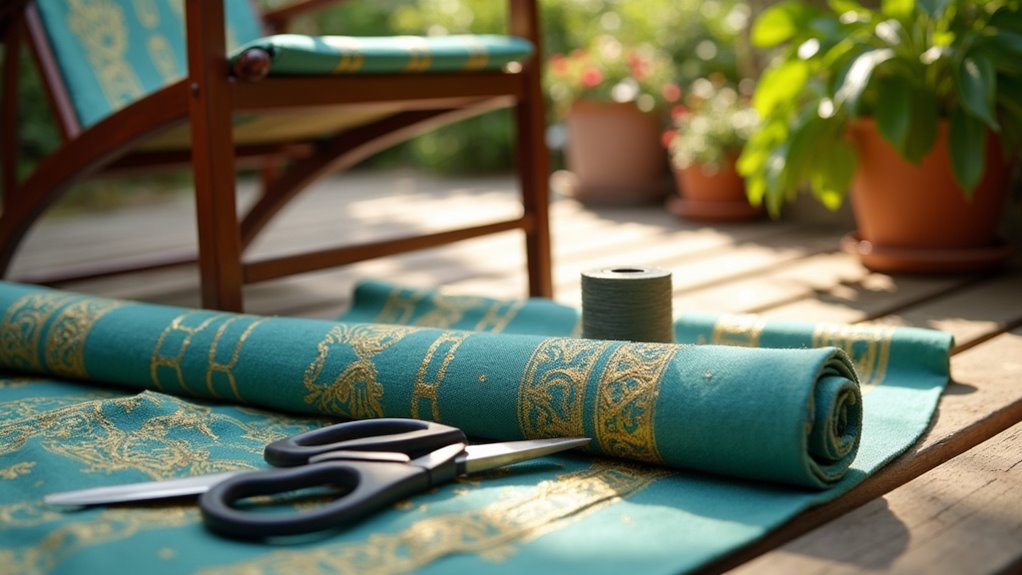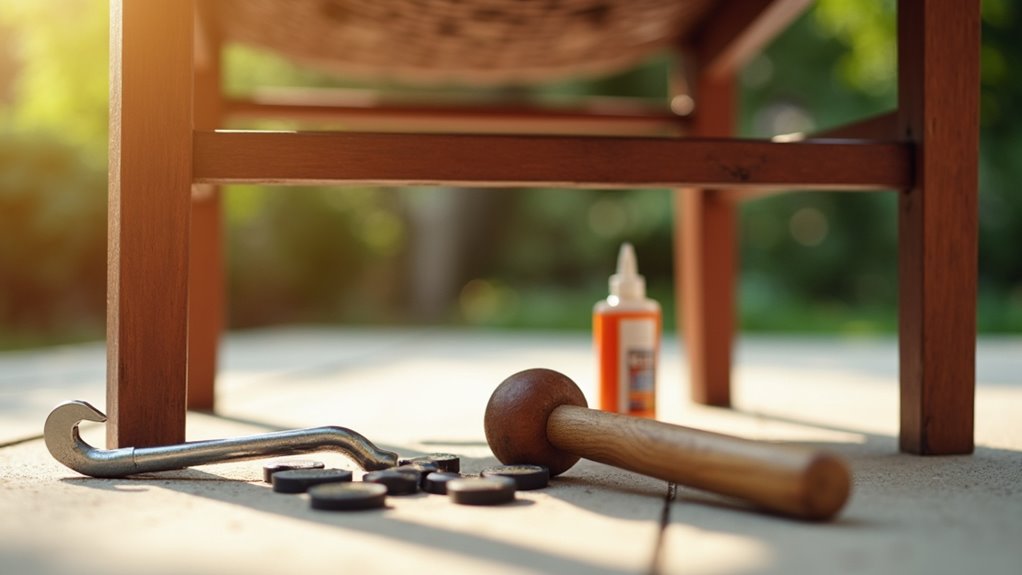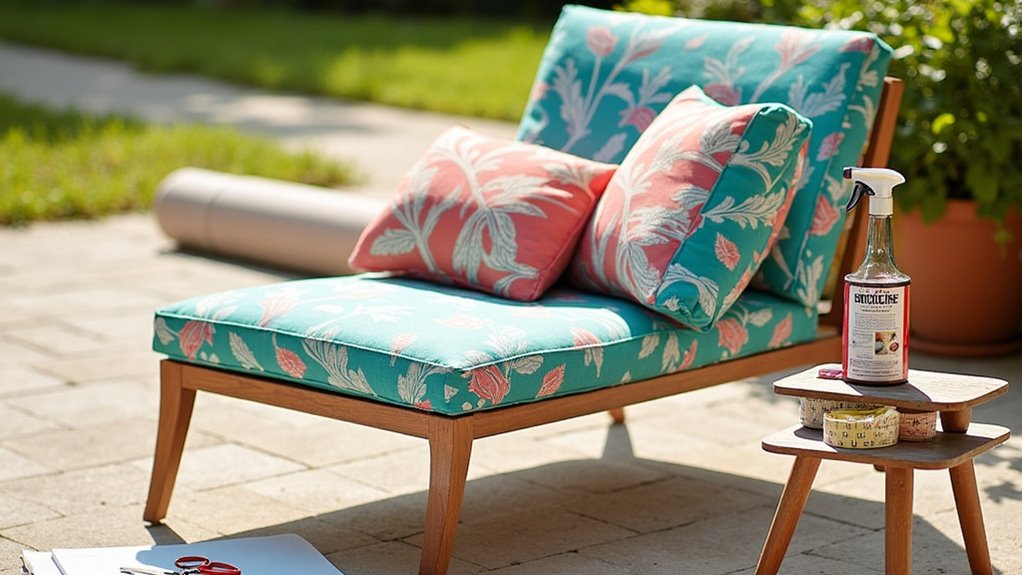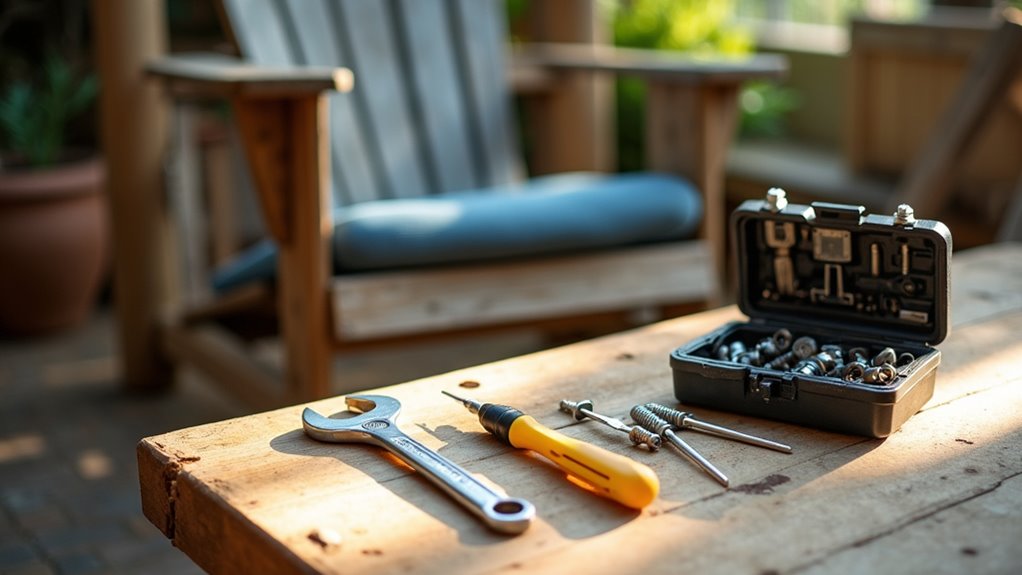How to Fix a Patio Chair
This post contains affiliate links. As an Amazon Associate, we earn from qualifying purchases.
Fixing a patio chair is straightforward and can be done with a few simple steps. Start by checking for wobbly legs—tighten any loose screws or bolts. If the sling is sagging, measure it and patch it with strong outdoor fabric. For rust on metal frames, sand it down and repaint with weather-resistant paint. Additionally, clean the cushions with mild soap, and use vinegar for any stains. More detailed explanations and tips will follow for those looking to delve deeper into the repair process.
Essential Facts in 30 Seconds
- Tighten loose screws or bolts to fix wobbly legs and ensure stability.
- Sand rust on metal frames and apply rust-resistant paint for protection.
- Use wood glue to reinforce loose joints for structural integrity.
- Clean cushions regularly and address stains promptly for longevity.
- Regularly inspect screws, joints, and surfaces to extend the chair’s lifespan.
Assessing Common Patio Chair Issues
Fixing your patio chair? Start by checking for common problems.
Look closely at the legs. Wobbly legs often mean loose screws or bolts. Use a screwdriver to tighten them. If the chair still wobbles, look for cracks or warping. These issues can be serious. You may need to reinforce the frame or replace parts. Wood glue can help joints stay strong and last longer. Inspecting overall stability is essential for ensuring your chair remains safe to use. Regularly checking for loose screws or bolts can prevent wobbly legs from becoming a recurring issue.
Next, check for rust on metal frames. Rust can weaken the chair. Sand it down and apply rust-resistant paint. This keeps your chair looking good and sturdy. Regular inspections help catch problems early, as weather-resistant materials are crucial for maintaining the longevity of your patio furniture. With a little effort, you can make your patio chair feel like new again!
Fabric and Sling Chair Repairs

After checking the frame and legs of your patio chair, focus on the fabric and sling.
Start with cleaning. Use mild detergent and water. Gently scrub the damaged area. This gives your chair a fresh look. Rinse well. Let it dry completely. This helps prevent mold and avoids mildew growth. Regular cleaning of your chair cushions can also enhance their longevity and appearance. Measure length of sling chair mesh to ensure you select the right fabric patch for the repair. Additionally, make sure to use outdoor fabric that can withstand the elements for a longer-lasting repair.
Next, select a patch. Choose fabric that matches the original. Cut the patch larger than the damage. This ensures good coverage. For sling chairs, measure carefully for the right fit.
Reattach the patch using strong outdoor thread. This adds durability. Use backstitching to secure it. Your chair will look brand new soon!
Metal Frame Restoration and Repair
Get your patio chair looking brand new!
Start by removing rust. Use a wire brush or sandpaper. Scrub those rust spots until they’re gone.
Next, clean the frame well. This makes sure the paint sticks. Regular maintenance can help prevent rusted frames from becoming a recurring issue.
Choose a weather-resistant paint. Apply it evenly for a smooth finish. Allow it to dry completely.
Now your chair is ready! Enjoy your outdoor space in style.
Rust Removal Techniques
Got a rusty patio chair? No need to stress! You can fix it easily. Start with simple items like white vinegar or baking soda. Mix them with water to make a paste. Use steel wool or aluminum foil balls to scrub the rust away. They work really well!
For tough spots, mix salt and lemon juice. This combo packs a punch against rust. Rinse everything off thoroughly when you’re done.
Still see rust? Try rust converters. They stop rust from coming back. Always wear gloves and goggles for safety while using these products.
After cleaning, dry your metal chair completely. This step helps prevent future rust. Give your chair a fresh start. It deserves it!
Painting and Finishing Tips
After fixing the rust, it’s time to paint your patio chair. A fresh coat will make it look great and protect it from weather.
Start by preparing the surface. Remove loose paint and dirt. Sand the frame until it’s smooth.
Pick a paint made for metal, like Rust-Oleum. A paint with built-in primer makes it easier to apply. Flat or matte finishes work best for touch-ups.
Apply several light coats. This helps prevent drips and gives a nice finish.
Don’t forget to add a top coat for extra protection. Let the chair cure for 24-48 hours. This step is important.
A little care keeps your patio chair looking fantastic. Enjoy your painting project!
Fixing Wobbly Chairs

Wobbly chairs can be fixed easily. Start by tightening screws and bolts. These are often the main cause of wobbling. A simple check can make a big difference.
Look for rusty or stripped hardware. Inspect the connection points and replace any old parts with new ones. This will help your chair feel sturdy again. If the legs are uneven, consider using furniture pads to help level them out.
Sometimes, the legs might be uneven. Use small pads or adjust the legs to balance the chair. Additionally, consider fixing wobbly legs by removing and re-gluing any loose joints for a more secure foundation.
Keep your chair safe and stable. Enjoy sitting comfortably!
Tighten Screws and Bolts
Fixing a wobbly patio chair starts with tightening screws and bolts. This is the best way to make your chair stable. Use the right tools, like screwdrivers or Allen wrenches that fit your screws.
Here are some helpful tips:
- Check each screw for looseness.
- Tighten screws in small steps to avoid breaking them.
- Use a crisscross pattern for even tightening.
Place the chair on a flat surface. Make sure all legs touch the ground evenly. If it still wobbles, adjust the screws a bit more. If the chair leg remains loose after tightening, consider applying wood glue to ensure a stronger bond. Additionally, regular maintenance can prolong the chair’s lifespan and appearance. Regularly inspect screws and joints for tightness to maintain stability.
With these easy steps, your chair will be steady and ready for summer BBQs. Enjoy your DIY success!
Inspect and Replace Hardware
Inspecting and replacing hardware on your patio chair can make a big difference. It’s like giving your chair a mini makeover!
Start by finding out which part is causing the wobble. Check the rivets, brackets, or glides. Measure these parts to ensure you get the right fit.
Grab your tools. A rivet remover or screwdriver works well for this job. For stubborn fasteners, heat or lubricant can help.
Remove the old hardware carefully. Follow the manufacturer’s instructions for the new installation.
Make sure everything is tight, but not too tight. A broken chair isn’t fun!
With the right tools and parts, your chair will be stable and ready for summer enjoyment.
Cushion and Upholstery Care

Caring for your patio chair cushions is easy. With a few simple steps, your cushions can stay fresh and clean all season. Here’s how to do it:
- Clean your cushions at least twice a year. Do this before winter storage and before spring use.
- Mix mild soap with warm water. Use a soft cloth for light stains. For tough stains, a hard bristle brush works best. You can also use a vinegar and water mixture for tough stains as an effective treatment. Regularly vacuuming to remove debris can also help maintain their appearance.
- Act quickly when spills happen. Spilled ketchup? Treat that stain right away! Always let your cushions air dry completely, as this helps prevent mildew and ensures they are completely dry before reattaching.
Store them in a dry place. Remember to spray them with waterproof sealant every spring and mid-summer.
With these tips, your patio chair cushions will be ready for comfortable lounging!
Workspace Preparation and Tools

Setting up your workspace is key before fixing your patio chairs. Find a well-lit and ventilated space, like a garage or covered patio. This keeps you safe and comfortable while you work.
A sturdy, flat surface prevents spills and accidents.
Gather your tools first. You’ll need screwdrivers, sandpaper, and adhesives. Organize fasteners in labeled containers to avoid losing them. A portable caddy helps keep everything close.
Protect your work surface with old newspapers or drop cloths. This way, spills won’t ruin your space.
Clear away any trip hazards to stay focused on fixing those chairs. Get ready to make them look fabulous!
Frequently Asked Questions
How Long Do Patio Chair Repairs Typically Take?
Repair times for patio chairs can vary. Minor fixes usually take about 10 to 30 minutes. Replacing straps is more involved and may take 1 to 3 hours. Complex repairs can take several hours. The time depends on the materials used and your skill level. It’s important to plan ahead for these tasks.
Can I Use Any Fabric for Sling Replacements?
Not all fabrics work for sling replacements. Using the wrong material is like trying to build a spaceship with cardboard! Specialized fabrics are best. They offer strength, comfort, and weather resistance. Look for materials made for sling chairs. These fabrics last longer and handle outdoor conditions better. Comfort matters too. Choose something soft against your skin. Remember, the right fabric makes a big difference for your sling chair. It keeps you safe and comfortable while you relax.
What Tools Are Essential for Patio Chair Repair?
Patio chair repair requires a few essential tools. Wrenches help with fixing the frame. Utility knives are perfect for replacing slings. Measuring tools ensure everything fits just right. Use adhesives to keep parts secure. Having these tools on hand makes your repair project easier and more successful.
Are There Any Eco-Friendly Paint Options for Metal Frames?
A garden needs love and care. Eco-friendly paint options for metal frames help protect it. These paints are strong and safe for both your furniture and the planet. They come in many colors and finishes. You can find non-toxic options at local stores or online. Many brands now focus on making paints that are good for the earth. This way, you keep your outdoor space beautiful and healthy. Your choice matters. It creates a better environment for everyone. Enjoy your garden while being kind to nature!
How Can I Prevent Future Damage to My Patio Chairs?
To keep your patio chairs in great shape, regular maintenance is key. Use waterproof covers to protect them from rain. Elevate the chairs off the damp ground to avoid rust or rot. Store them inside during harsh weather to prevent damage. Clean your chairs often to remove dirt and grime. Check for any loose parts and fix them right away. With these simple steps, your patio chairs will last longer and stay looking good.
Conclusion
Get ready to fix those patio chairs! Repairing a chair gives it a new life. It’s like making a superhero out of old furniture. You can patch up fabric or tighten wobbly legs. With the right tools, you can make your chairs comfy again. Your patio will soon be the best place to relax. Enjoy the sunny days ahead! High-five!
